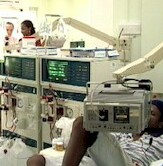
SATURDAY, Nov. 20 (HealthDay News) — Kidney failure patients who double the number of weekly dialysis treatments typically prescribed had significantly better heart function, overall health and general quality of life, new research indicates.
The finding stems from an analysis that compared the impact of the 40-year-old standard of care — three dialysis treatments per week, for three to four hours per session — with a six-day a week treatment regimen involving sessions of 2.5 to three hours per session.
Launched in 2006, the comparison involved 245 dialysis patients assigned to either a standard dialysis schedule or the high-frequency option. All participants underwent MRIs to assess heart muscle structure, and all completed quality-of-life surveys.
In addition to improved cardiovascular health and overall health, the analysis further revealed that two concerns faced by most kidney failure patients — blood pressure and phosphate level control — also fared better under the more frequent treatment program.
Dr. Glenn Chertow, chief of the nephrology division at Stanford University School of Medicine, reports his team’s observations in the Nov. 20 online edition of the New England Journal of Medicine, to coincide with a presentation at the annual meeting of the American Society of Nephrology in Denver.
“Kidneys work seven days a week, 24 hours a day,” Chertow noted in a Stanford University news release. “You could imagine why people might feel better if dialysis were to more closely mimic kidney function. But you have to factor in the burden of additional sessions, the travel and the cost.”
To the latter point, the authors noted that dialysis is expensive, and Medicare currently only covers the conventional three-day per week approach, which over the course of a year amounts to somewhere between $75,000 to $100,000. A doubling of this standard would therefore amount to an expensive proposition for many patients.
Another drawback was the observation that doubling dialysis treatment also increased the number of procedures patients had to undergo to deal with the side effects prompted by more frequent insertion of tubes into the body.
That said, the study team suggested that future treatment plans should be constructed case-by-case.
“I’m certainly not going to recommend six times a week for all my patients,” said Chertow, who is also a professor of medicine at Stanford. “One size does not fit all. For some patients with kidney failure, no dialysis is the right treatment. For others, it’s three times a week in-center. For others, it’s home-based dialysis. For others, perhaps six times a week.”
For his part, Dr. Matthew Weir, director of the division of nephrology at the University of Maryland School of Medicine in Baltimore, said that the apparent benefits of high-frequency dialysis “make a lot of sense.”
“A normal kidney works 168 hours a week filtering our blood and removing fluid,” he explained. “But with dialysis we try to do the same work intermittently just three times a week, for three to four hours each time. And that’s clearly a major problem for dialysis patients, because it’s a very harsh form of fluid removal that can stretch and strain the heart and leave patients feeling unwell,” Weir noted.
“So I would say that an increased use of dialysis is a more facile approach to controlling blood volume, because it removes fluid in a more sustained and more natural way, which the heart prefers. So ultimately, you have less strain on the heart, less heart failure and patients living longer,” Weir said.
More information
For more on kidney failure and dialysis, visit the U.S. National Institute of Diabetes and Digestive and Kidney Diseases.

